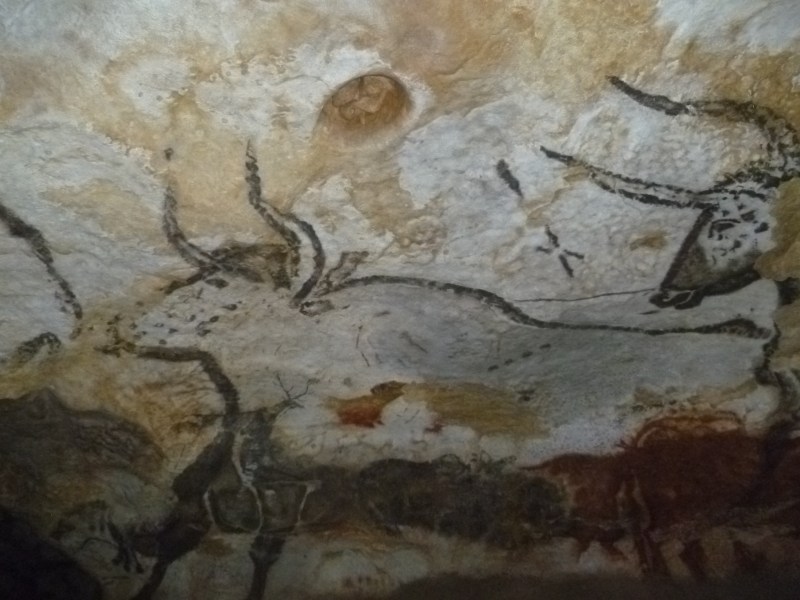We modern humans tend to take writing for granted, and often forget that like any other technology, somebody had to invent it. Researchers from Cambridge believe they’ve determined the purpose of one of the earliest writing beta-tests.
Examining a database of images taken in caves throughout Europe and dated to the Upper Paleolithic, the researchers found “three of the most frequently occurring signs—the line <|>, the dot <•>, and the <Y>—functioned as units of communication.”
It appears the <|> and <.> symbols when “in close association with images of animals” denote time relating to lunar months of the year, starting with spring as the new year. The <Y> symbol appears to carry the meaning <To Give Birth> allowing early people a way to tell others information about the prey of a region, which would be pretty handy when hunting and gathering are your only options for food.
We’ve covered other ancient technologies like storytelling and abrasives. If you’re curious what the climate was like for our ancestors, perhaps paleoclimatology will tickle your fancy.
















Are they saying that cave paintings were utilitarian? That their purpose was to tell whoever might be passing through what game was available in the area and when?
I could also see it as the paintings being religious (as in, worshiping the animals they rely on) with a different hand adding practical notes to the effect of “these things are great, hunt them around [time of year].”
The symbol shows branching in the prey process…
This poses two problems: the readability of the message as well as its universality within Paleolithic Europe.
The fact that these messages were discovered in caves not always very accessible does not exclude that these same messages could also have been available much more accessible during this period outside the caves, but that they were erased by time, erosion and climate.
Of course the caves are very protected environments and therefore much more favorable to the conservation of paleolithic paintings and engravings, in the same way for example that it would be stupid to think that the ancient Egyptians built everything with stones: they also built with Raw brick, but it did not resist very long and disappeared without leaving many clues.
Regarding the “European” character of the message, this is a much more astonishing thing. Can this mean that human groups in the European Paleolithic had much more exchanges than we imagined? It’s entirely possible…
Extract from the research paper :
“It is unclear to us how visible, accessible, or universally shared this information would have been. While we might assume that portable art found in domestic contexts was visible to many or all, this of course does not necessarily imply that everyone could ‘read’ its message. With parietal art, at least that created in deep caves, we simply do not know who its audience were; perhaps it was viewed by many, or perhaps shared only with a minority of ‘literate’ initiates ‘in the know’ (e.g. Hayden Reference Hayden2018). Likewise, we are not claiming that the function of the system was incompatible with other aesthetic, didactic or ritual aspects of Palaeolithic visual culture (cf. Bahn Reference Bahn2016), or that it explains all associations of lines/dots with animals, or that it was practised at all times and by all groups across Upper Palaeolithic Europe. We of course acknowledge that far more examples of animal depictions occur without associated signs, and of course do not imply that our interpretations include these.”
Btw some years ago I went to the Rouffignac & (copy of) Lascaux caves ans this was a memorable experience !
“Can this mean that human groups in the European Paleolithic had much more exchanges than we imagined?”
It depends how much exchange you imagined! AIUI archaeologists have recognised for a while that populations in Europe were always highly mobile – not only migration, but trade, such that cultures across the continent (and beyond) communicated as far back as anyone can tell.
If a paleolithic HaD reader in Ukraine came up with a new beaker design, readers in Britain and Turkey would find out about it, and then if they created a new cord-marked version, that would get back to the original designer(‘s descendants). Messaging may have taken years instead of milliseconds, but culture also moved much more slowly overall, so from our perspective thousands of years later it’s almost as if they had the internet. Information might actually have spread more freely then than in the middle ages, when culture became siloed into nation-states.
I have a lot !
I once read a paper about paleolitic knapped flint : reseachers found that flint stones from known production centers were found in areas far away and that it was fairly common, which meant there was – as you wrote – an established flint trading network across Europe.
” we have been trying to reach you regarding your extended spear warranty!”
My favorites are the Vikings, who would make pointless or humorous runic inscriptions such as “this is really high” written in small characters on the roof of a cave, or a set of runes on a partially-buried stone where only the tops of the runes were visible. Once excavated, the inscription translated “I wrote this very tall.”
Halfdan was here
It’s cave-ma’am!